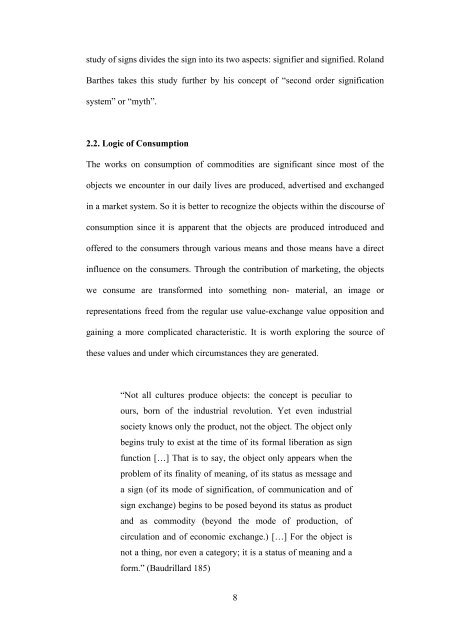virtualization of design and production a thesis - Bilkent University
virtualization of design and production a thesis - Bilkent University
virtualization of design and production a thesis - Bilkent University
Create successful ePaper yourself
Turn your PDF publications into a flip-book with our unique Google optimized e-Paper software.
study <strong>of</strong> signs divides the sign into its two aspects: signifier <strong>and</strong> signified. Rol<strong>and</strong><br />
Barthes takes this study further by his concept <strong>of</strong> “second order signification<br />
system” or “myth”.<br />
2.2. Logic <strong>of</strong> Consumption<br />
The works on consumption <strong>of</strong> commodities are significant since most <strong>of</strong> the<br />
objects we encounter in our daily lives are produced, advertised <strong>and</strong> exchanged<br />
in a market system. So it is better to recognize the objects within the discourse <strong>of</strong><br />
consumption since it is apparent that the objects are produced introduced <strong>and</strong><br />
<strong>of</strong>fered to the consumers through various means <strong>and</strong> those means have a direct<br />
influence on the consumers. Through the contribution <strong>of</strong> marketing, the objects<br />
we consume are transformed into something non- material, an image or<br />
representations freed from the regular use value-exchange value opposition <strong>and</strong><br />
gaining a more complicated characteristic. It is worth exploring the source <strong>of</strong><br />
these values <strong>and</strong> under which circumstances they are generated.<br />
“Not all cultures produce objects: the concept is peculiar to<br />
ours, born <strong>of</strong> the industrial revolution. Yet even industrial<br />
society knows only the product, not the object. The object only<br />
begins truly to exist at the time <strong>of</strong> its formal liberation as sign<br />
function […] That is to say, the object only appears when the<br />
problem <strong>of</strong> its finality <strong>of</strong> meaning, <strong>of</strong> its status as message <strong>and</strong><br />
a sign (<strong>of</strong> its mode <strong>of</strong> signification, <strong>of</strong> communication <strong>and</strong> <strong>of</strong><br />
sign exchange) begins to be posed beyond its status as product<br />
<strong>and</strong> as commodity (beyond the mode <strong>of</strong> <strong>production</strong>, <strong>of</strong><br />
circulation <strong>and</strong> <strong>of</strong> economic exchange.) […] For the object is<br />
not a thing, nor even a category; it is a status <strong>of</strong> meaning <strong>and</strong> a<br />
form.” (Baudrillard 185)<br />
8
















